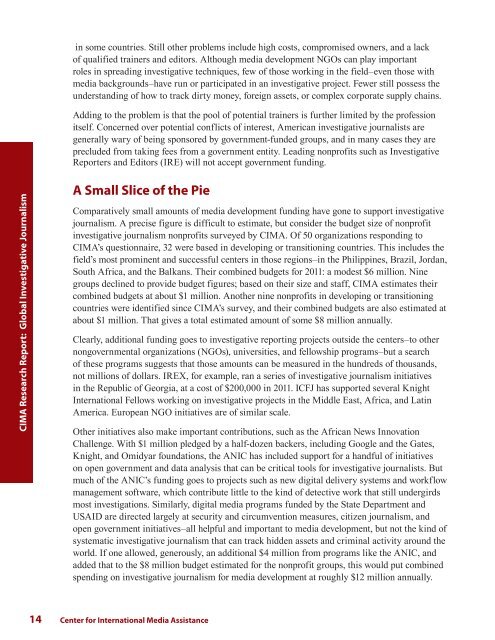CIMA-Investigative Journalism - Dave Kaplan
CIMA-Investigative Journalism - Dave Kaplan
CIMA-Investigative Journalism - Dave Kaplan
Create successful ePaper yourself
Turn your PDF publications into a flip-book with our unique Google optimized e-Paper software.
<strong>CIMA</strong> Research Report: Global <strong>Investigative</strong> <strong>Journalism</strong><br />
in some countries. Still other problems include high costs, compromised owners, and a lack<br />
of qualified trainers and editors. Although media development NGOs can play important<br />
roles in spreading investigative techniques, few of those working in the field–even those with<br />
media backgrounds–have run or participated in an investigative project. Fewer still possess the<br />
understanding of how to track dirty money, foreign assets, or complex corporate supply chains.<br />
Adding to the problem is that the pool of potential trainers is further limited by the profession<br />
itself. Concerned over potential conflicts of interest, American investigative journalists are<br />
generally wary of being sponsored by government-funded groups, and in many cases they are<br />
precluded from taking fees from a government entity. Leading nonprofits such as <strong>Investigative</strong><br />
Reporters and Editors (IRE) will not accept government funding.<br />
A Small Slice of the Pie<br />
Comparatively small amounts of media development funding have gone to support investigative<br />
journalism. A precise figure is difficult to estimate, but consider the budget size of nonprofit<br />
investigative journalism nonprofits surveyed by <strong>CIMA</strong>. Of 50 organizations responding to<br />
<strong>CIMA</strong>’s questionnaire, 32 were based in developing or transitioning countries. This includes the<br />
field’s most prominent and successful centers in those regions–in the Philippines, Brazil, Jordan,<br />
South Africa, and the Balkans. Their combined budgets for 2011: a modest $6 million. Nine<br />
groups declined to provide budget figures; based on their size and staff, <strong>CIMA</strong> estimates their<br />
combined budgets at about $1 million. Another nine nonprofits in developing or transitioning<br />
countries were identified since <strong>CIMA</strong>’s survey, and their combined budgets are also estimated at<br />
about $1 million. That gives a total estimated amount of some $8 million annually.<br />
Clearly, additional funding goes to investigative reporting projects outside the centers–to other<br />
nongovernmental organizations (NGOs), universities, and fellowship programs–but a search<br />
of these programs suggests that those amounts can be measured in the hundreds of thousands,<br />
not millions of dollars. IREX, for example, ran a series of investigative journalism initiatives<br />
in the Republic of Georgia, at a cost of $200,000 in 2011. ICFJ has supported several Knight<br />
International Fellows working on investigative projects in the Middle East, Africa, and Latin<br />
America. European NGO initiatives are of similar scale.<br />
Other initiatives also make important contributions, such as the African News Innovation<br />
Challenge. With $1 million pledged by a half-dozen backers, including Google and the Gates,<br />
Knight, and Omidyar foundations, the ANIC has included support for a handful of initiatives<br />
on open government and data analysis that can be critical tools for investigative journalists. But<br />
much of the ANIC’s funding goes to projects such as new digital delivery systems and workflow<br />
management software, which contribute little to the kind of detective work that still undergirds<br />
most investigations. Similarly, digital media programs funded by the State Department and<br />
USAID are directed largely at security and circumvention measures, citizen journalism, and<br />
open government initiatives–all helpful and important to media development, but not the kind of<br />
systematic investigative journalism that can track hidden assets and criminal activity around the<br />
world. If one allowed, generously, an additional $4 million from programs like the ANIC, and<br />
added that to the $8 million budget estimated for the nonprofit groups, this would put combined<br />
spending on investigative journalism for media development at roughly $12 million annually.<br />
14 Center for International Media Assistance


